Abstract
Twenty-four pregnant cows were vaccinated intramuscularly with K99 extract from enterotoxigenic Escherichia coli and inactivated rotavirus as follows: six cows were injected with 2 ml of oil-adjuvanted vaccine; six cows were injected with 0.5 ml of oil-adjuvanted vaccine; six cows were injected with 4 ml of aluminum hydroxide-adjuvanted vaccine twice with a four-week interval; and six cows were unvaccinated as controls. Calves born to these cows were challenged with enterotoxigenic E. coli at 6 to 18 h after birth. Serum and milk antibodies to K99 and rotavirus in cows vaccinated with either dose of oil vaccine were significantly increased until at least 28 days after calving. In cows vaccinated with alhydrogel vaccine, there was a significant K99 antibody increase in serum and in colostrum but not in milk and a significant rotavirus antibody increase only in colostrum. Five of six calves born to unvaccinated cows developed enterotoxic colibacillosis after challenge, and all excreted the challenge strain of enterotoxigenic E. coli. None of the 18 calves in the three vaccinated groups developed clinical colibacillosis, and fecal excretion of the challenge organism was reduced. A combined enterotoxigenic E. coli-rotavirus vaccine may prove useful in preventing some outbreaks of calf diarrhea.
Full text
PDF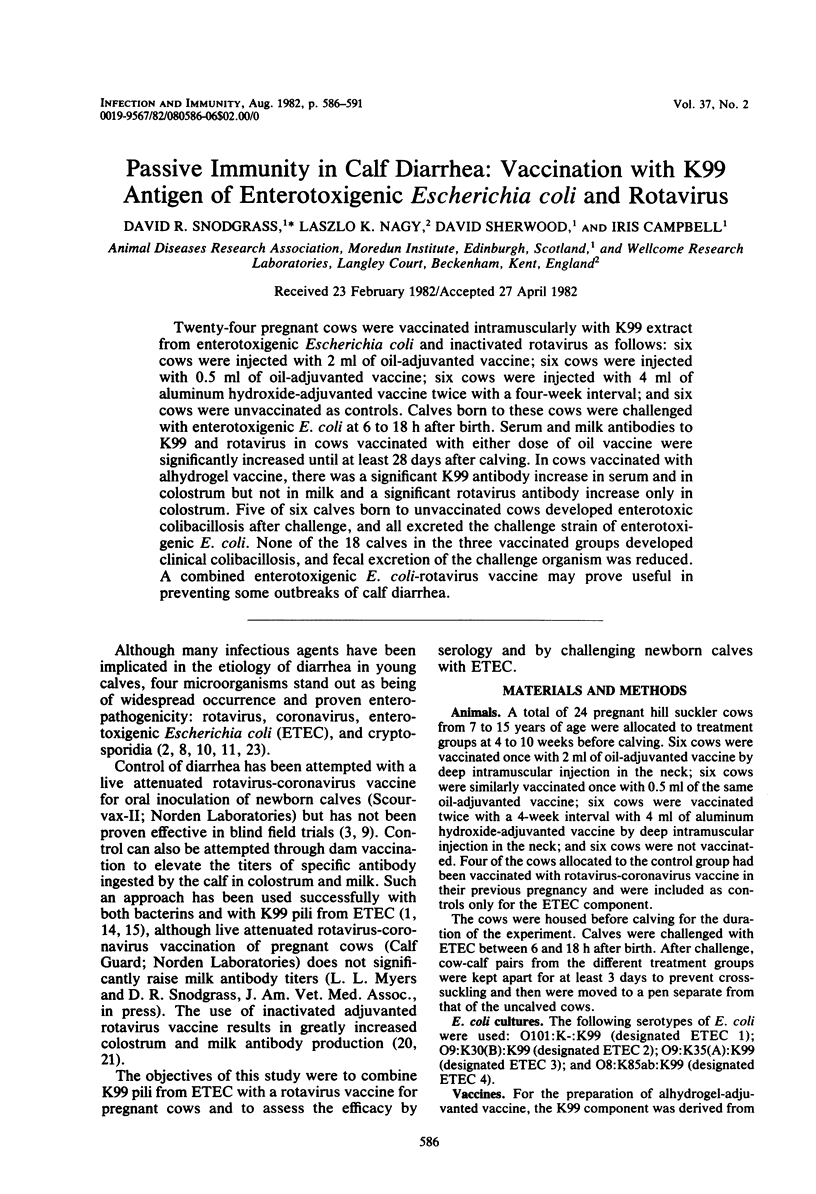
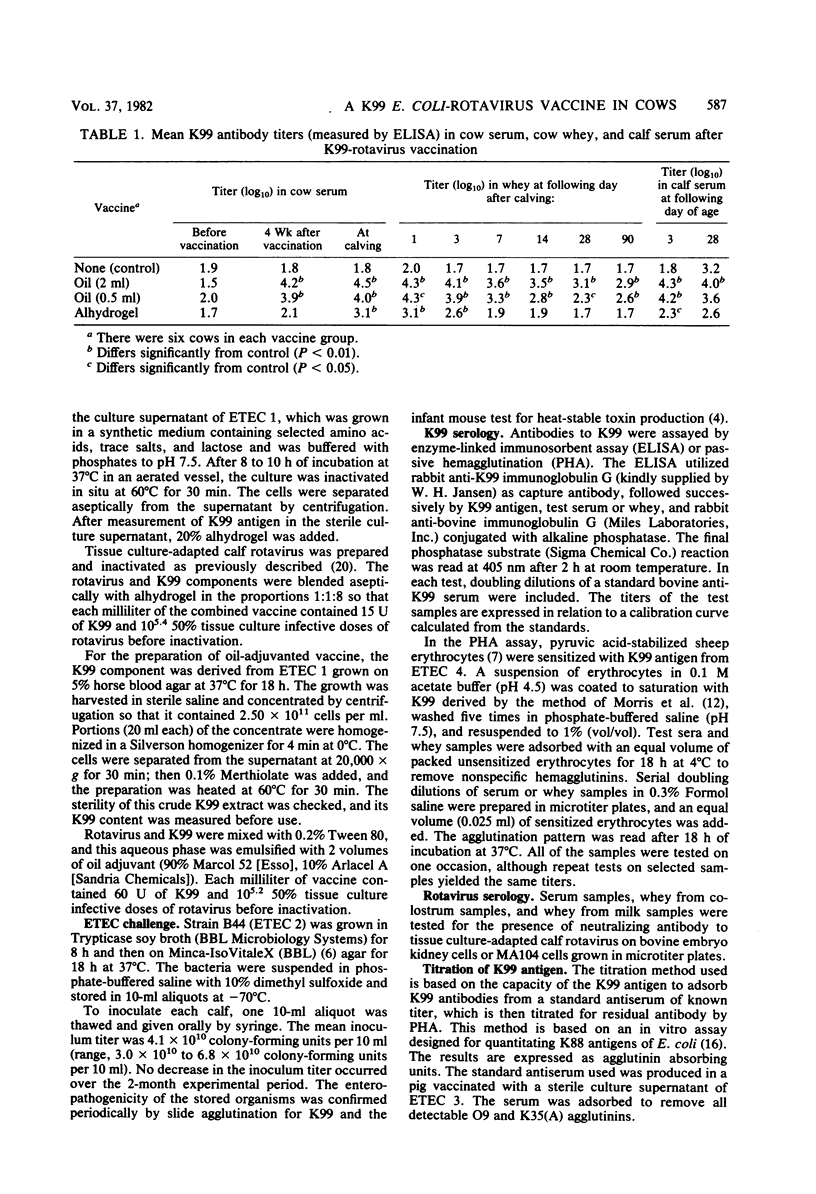
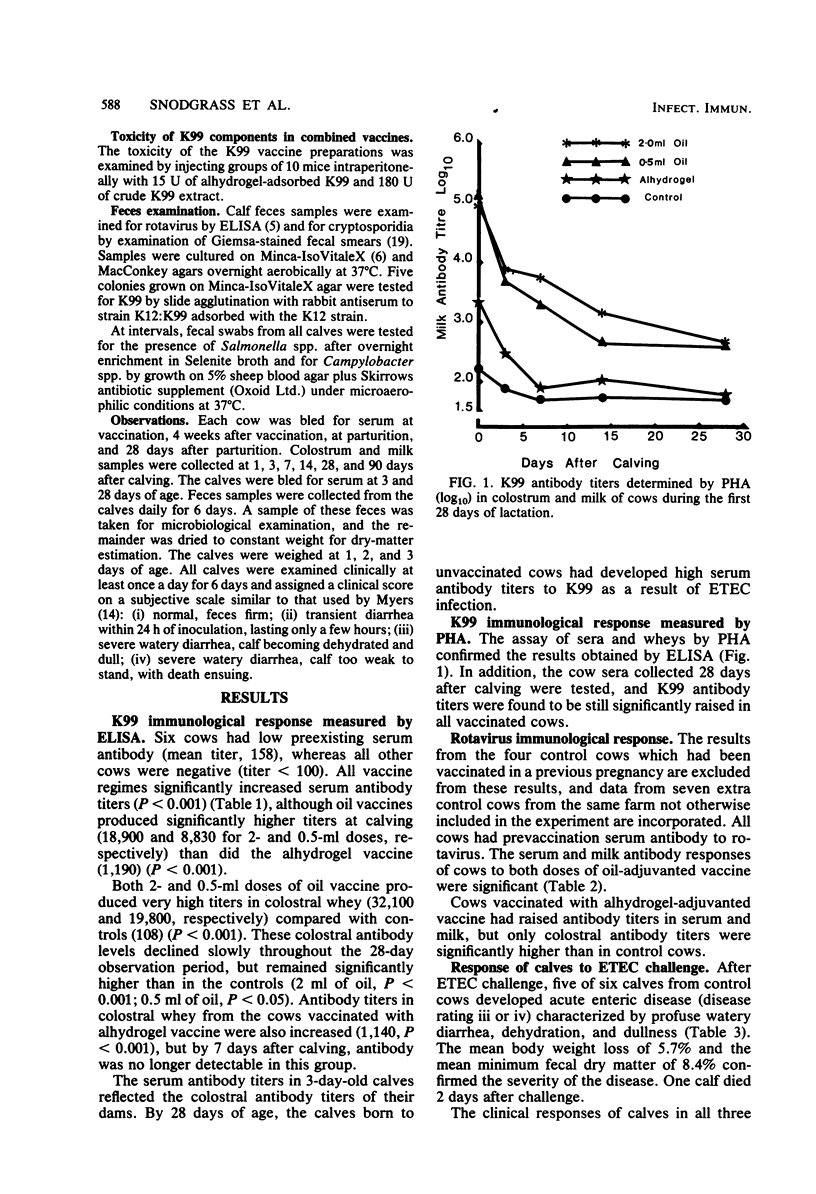
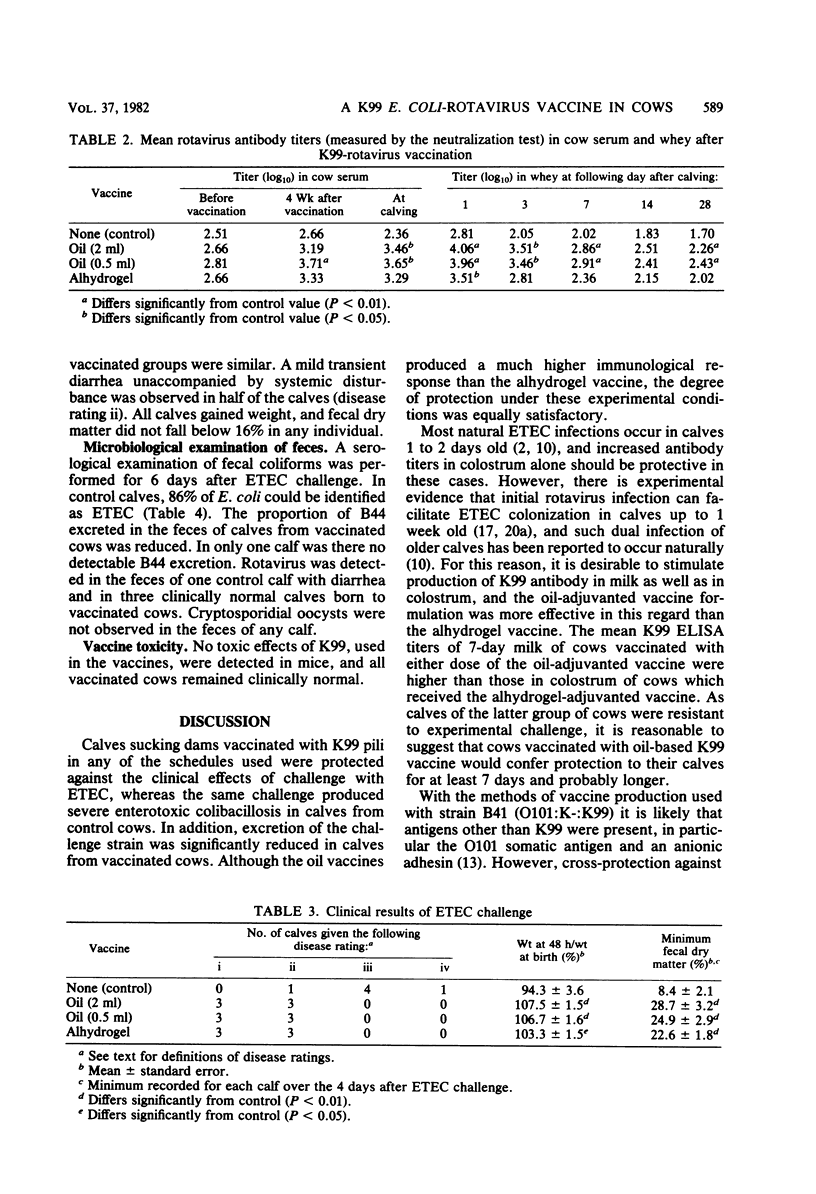
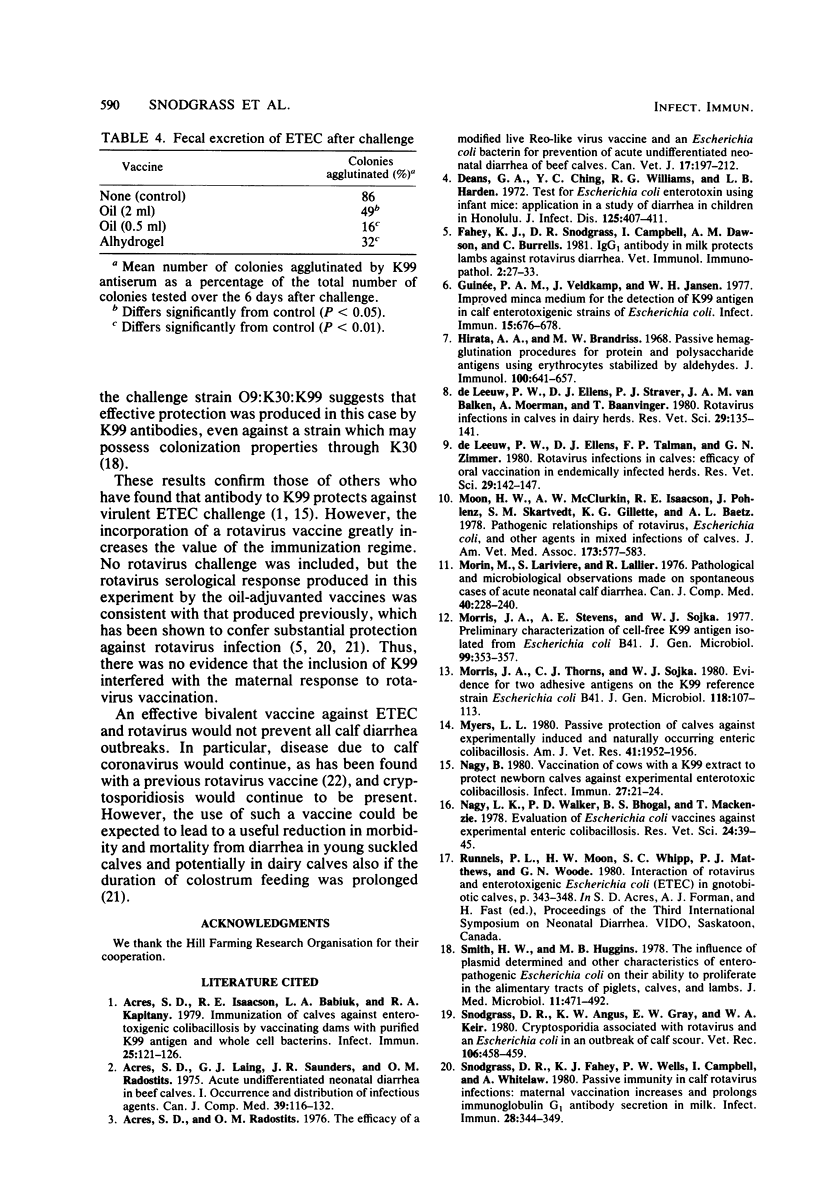
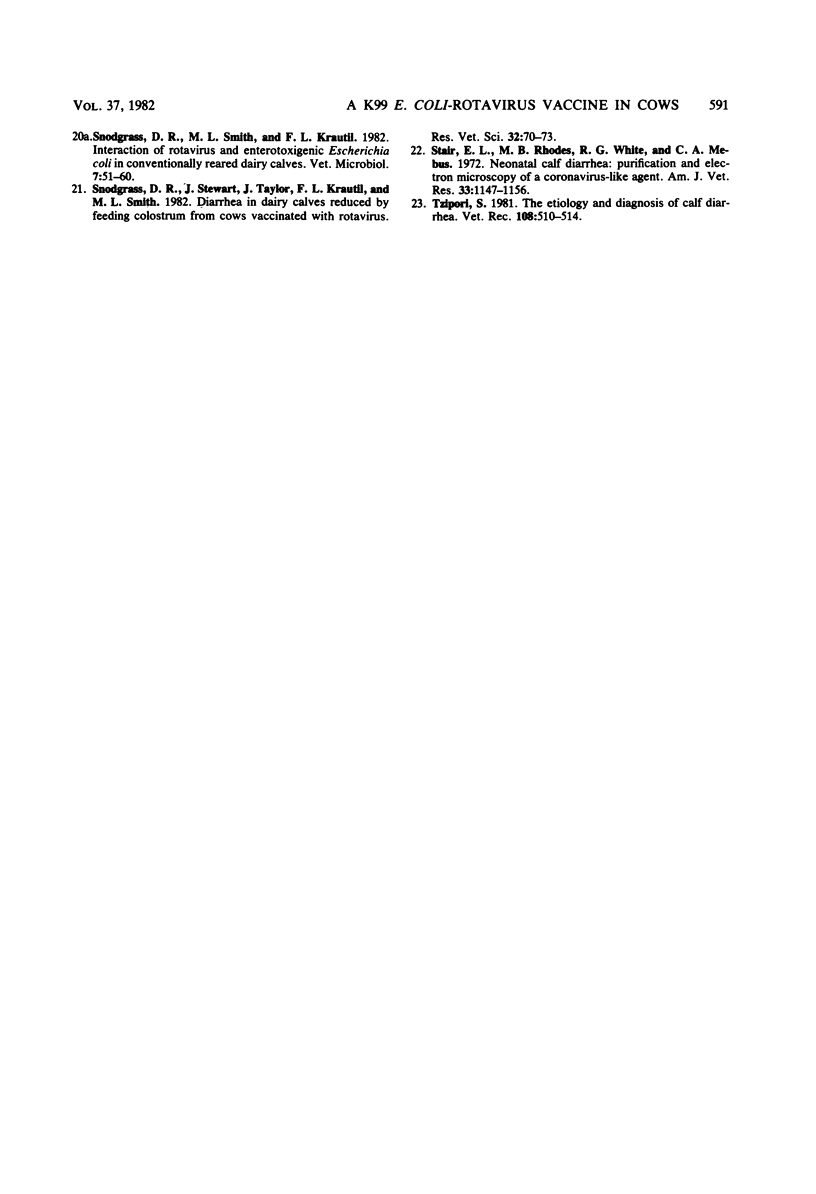
Selected References
These references are in PubMed. This may not be the complete list of references from this article.
- Acres S. D., Isaacson R. E., Babiuk L. A., Kapitany R. A. Immunization of calves against enterotoxigenic colibacillosis by vaccinating dams with purified K99 antigen and whole cell bacterins. Infect Immun. 1979 Jul;25(1):121–126. doi: 10.1128/iai.25.1.121-126.1979. [DOI] [PMC free article] [PubMed] [Google Scholar]
- Acres S. D., Laing C. J., Saunders J. R., Radostits O. M. Acute undifferentiated neonatal diarrhea in beef calves. I. Occurence and distribution of infectious agents. Can J Comp Med. 1975 Apr;39(2):116–132. [PMC free article] [PubMed] [Google Scholar]
- Acres S. D., Radostits O. M. The efficacy of a modified live reo-like virus vaccine and an E. coli bacterin for prevention of acute undifferentiated neonatal diarrhea of beef calves. Can Vet J. 1976 Aug;17(8):197–212. [PMC free article] [PubMed] [Google Scholar]
- Dean A. G., Ching Y. C., Williams R. G., Harden L. B. Test for Escherichia coli enterotoxin using infant mice: application in a study of diarrhea in children in Honolulu. J Infect Dis. 1972 Apr;125(4):407–411. doi: 10.1093/infdis/125.4.407. [DOI] [PubMed] [Google Scholar]
- Fahey K. J., Snodgrass D. R., Campbell I., Dawson A. M., Burrells C. IgG1 antibody in milk protects lambs against rotavirus diarrhoea. Vet Immunol Immunopathol. 1981 Feb;2(1):27–33. doi: 10.1016/0165-2427(81)90036-2. [DOI] [PubMed] [Google Scholar]
- Guinée P. A., Veldkamp J., Jansen W. H. Improved minca medium for the detection of K99 antigen in calf enterotoxigenic strains of Escherichia coli. Infect Immun. 1977 Feb;15(2):676–678. doi: 10.1128/iai.15.2.676-678.1977. [DOI] [PMC free article] [PubMed] [Google Scholar]
- Hirata A. A., Brandriss M. W. Passive hemagglutination procedures for protein and polysaccharide antigens using erythrocytes stabilized by aldehydes. J Immunol. 1968 Mar;100(3):641–646. [PubMed] [Google Scholar]
- Moon H. W., McClurkin A. W., Isaacson R. E., Pohlenz J., Skartvedt S. M., Gillette K. G., Baetz A. L. Pathogenic relationships of rotavirus, Escherichia coli, and other agents in mixed infections in calves. J Am Vet Med Assoc. 1978 Sep 1;173(5 Pt 2):577–583. [PubMed] [Google Scholar]
- Morin M., Larivière S., Lallier R. Pathological and microbiological observations made on spontaneous cases of acute neonatal calf diarrhea. Can J Comp Med. 1976 Jul;40(3):228–240. [PMC free article] [PubMed] [Google Scholar]
- Morris J. A., Stevens A. E., Sojka W. J. Preliminary characterization of cell-free K99 antigen isolated from Escherichia coli B41. J Gen Microbiol. 1977 Apr;99(2):353–357. doi: 10.1099/00221287-99-2-353. [DOI] [PubMed] [Google Scholar]
- Morris J. A., Thorns C. J., Sojka W. J. Evidence for two adhesive antigens on the K99 reference strain Escherichia coli B41. J Gen Microbiol. 1980 May;118(1):107–113. doi: 10.1099/00221287-118-1-107. [DOI] [PubMed] [Google Scholar]
- Myers L. L. Passive protection of calves against experimentally induced and naturally occurring enteric colibacillosis. Am J Vet Res. 1980 Dec;41(12):1952–1956. [PubMed] [Google Scholar]
- Nagy B. Vaccination of cows with a K99 extract to protect newborn calves against experimental enterotoxic colibacillosis. Infect Immun. 1980 Jan;27(1):21–24. doi: 10.1128/iai.27.1.21-24.1980. [DOI] [PMC free article] [PubMed] [Google Scholar]
- Nagy L. K., Walker P. D., Bhogal B. S., Mackenzie T. Evaluation of Escherichia coli vaccines against experimental enteric colibacillosis. Res Vet Sci. 1978 Jan;24(1):39–45. [PubMed] [Google Scholar]
- Smith H. W., Huggins M. B. The influence of plasmid-determined and other characteristics of enteropathogenic Escherichia coli on their ability to proliferate in the alimentary tracts of piglets, calves and lambs. J Med Microbiol. 1978 Nov;11(4):471–492. doi: 10.1099/00222615-11-4-471. [DOI] [PubMed] [Google Scholar]
- Snodgrass D. R., Angus K. W., Gray E. W., Keir W. A., Clerihew L. W. Cryptosporidia associated with rotavirus and an Escherichia coli in an outbreak of calf scour. Vet Rec. 1980 May 31;106(22):458–460. doi: 10.1136/vr.106.22.458-a. [DOI] [PubMed] [Google Scholar]
- Snodgrass D. R., Fahey K. J., Wells P. W., Campbell I., Whitelaw A. Passive immunity in calf rotavirus infections: maternal vaccination increases and prolongs immunoglobulin G1 antibody secretion in milk. Infect Immun. 1980 May;28(2):344–349. doi: 10.1128/iai.28.2.344-349.1980. [DOI] [PMC free article] [PubMed] [Google Scholar]
- Snodgrass D. R., Smith M. L., Krautil F. L. Interaction of rotavirus and enterotoxigenic Escherichia coli in conventionally-reared dairy calves. Vet Microbiol. 1982 Mar;7(1):51–60. doi: 10.1016/0378-1135(82)90005-0. [DOI] [PMC free article] [PubMed] [Google Scholar]
- Snodgrass D. R., Stewart J., Taylor J., Krautil F. L., Smith M. L. Diarrhoea in dairy calves reduced by feeding colostrum from cows vaccinated with rotavirus. Res Vet Sci. 1982 Jan;32(1):70–73. doi: 10.1016/S0034-5288(18)32440-8. [DOI] [PMC free article] [PubMed] [Google Scholar]
- Stair E. L., Rhodes M. B., White R. G., Mebus C. A. Neonatal calf diarrhea: purification and electron microscopy of a coronavirus-like agent. Am J Vet Res. 1972 Jun;33(6):1147–1156. [PubMed] [Google Scholar]
- de Leeuw P. W., Ellens D. J., Straver P. J., van Balken J. A., Moerman A., Baanvinger T. Rotavirus infections in calves in dairy herds. Res Vet Sci. 1980 Sep;29(2):135–141. doi: 10.1016/S0034-5288(18)32653-5. [DOI] [PMC free article] [PubMed] [Google Scholar]
- de Leeuw P. W., Ellens D. J., Talmon F. P., Zimmer G. N., Kommerij R. Rotavirus infections in calves: efficacy of oral vaccination in endemically infected herds. Res Vet Sci. 1980 Sep;29(2):142–147. doi: 10.1016/S0034-5288(18)32654-7. [DOI] [PMC free article] [PubMed] [Google Scholar]


